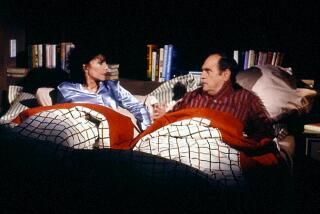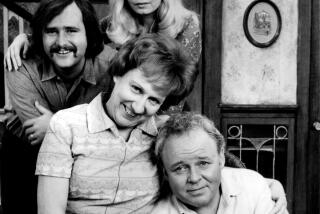Sneak Previews of Forthcoming Books of Special Interest to Southern Californians : The Voice Behind Bugs Bunny : ‘ “What’s up, Doc?” became the most famous ad-lib of my career.’
- Share via
FEW FANS OF the current Bugs Bunny would recognize him from his early career: oval-shaped head, jellybean nose and wide, innocent eyes. In addition to being a mere shadow of his future self, Bugs wasn’t even called Bugs, but Happy Rabbit.
“Happy Rabbit?” I exclaimed, while reading the script for “Porky’s Hare Hunt.” “That’s terrible,” I said to Leon Schlessinger (of Leon Schlessinger Productions, which produced Looney Tunes and Merrie Melodies).
“What would you suggest then, Mel?”
“Why not call him Bugs, after Ben Hardaway?” Hardaway had drawn him, so it seemed only fair. For reasons never explained, he’d been nicknamed Bugs as a child, and it stuck.
“Bugs Rabbit ?” said Schlessinger, recoiling as if he’d just been asked to sign an extra payroll that week.
I suggested we make it alliterative: Bugs Bunny. “Like Porky Pig,” I said, popping my P s, then doing the same for Bugs Bunny. The producer nodded.
Settling on a definitive characterization was a lot more difficult than selecting the name, if for no other reason than Hardaway kept changing the rabbit’s features on me. In “Hare-Um Scare-Um” he was an orthodontist’s dream, with badly protruding front teeth. The only way for me to incorporate this physical trait into his delivery was to speak with a lisp, but that made the voice hard to understand.
By the time of “A Wild Hare” (1940), which is considered Bugs Bunny’s debut, he’d obviously had some work done: His posture had improved, he’d shed some weight, and his overbite wasn’t as pronounced. The most significant change, however, was in his facial expression. No longer just goofy, he was a sly-looking rascal. “A tough little stinker, ain’t he?” Hardaway remarked, admiring his portrait of the new Bugs.
A tough little stinker . . . . In my mind I heard a Brooklyn accent. Consequently, the new, improved Bugs Bunny wouldn’t say jerk , he’d say joik. And the boisterous laugh I’d originally given him no longer fit. It was redeposited in my memory bank, to be withdrawn several years later for another Ben Hardaway creation: Woody Woodpecker. Likewise, a hep cat like Bugs wouldn’t say, “What’s cookin’?”--which originally was to have been his singular phrase--he’d employ something more contemporary.
“What’s up, Doc?” became the most famous ad-lib of my career. It was incomplete, however, without the sound of the rabbit nibbling on a carrot, which presented problems. First of all, I don’t especially like carrots. And second, I found it impossible to chew, swallow and be ready to say my next line. The solution was to stop tape so that I could spit out the carrot into a wastebasket and then proceed.
Despite his many transformations, one aspect of the rabbit remained constant: his audacity, apparent even in “Porky’s Hare Hunt.” “Here I am, Fat Boy!” he mercilessly taunts the hapless hunter. In another scene the rabbit declares, “Of course you realize, this means war,” a phrase that would be repeated in dozens of Bugs Bunny episodes. It was soon obvious, however, that he deserved a more imposing adversary than a mild-mannered pig.
Enter Elmer Fudd, destined to spend the next three decades being outsmarted by his prey. The tone of Elmer’s and Bugs’ relationship was set with their very first confrontation, in “A Wild Hare.” Clutching his trusty shotgun, the dimwitted hunter tiptoes through the woods and warns the audience: “Be vewy, vewy quiet--I’m hunting wabbits.” Suddenly he spies Bugs leaning against a tree, dashes over and levels his double-barrel at the rabbit’s chest. Elmer is befuddled when instead of cowering in fear, his target slaps a white-gloved mitt on the weapon and nonchalantly asks, “Eh, what’s up, Doc?”
Though Bugs always gains the upper hand, he is ultimately a pacifist, disarming Elmer with his wiles and appealing to underdog-rooting audiences. Director Bob Clampett contended it was no coincidence that the rabbit first achieved his popularity during the war years. To a public outraged over Pearl Harbor and Nazi atrocities, headstrong, brain-dead Elmer symbolized the Axis Powers. Cocky, fearless Bugs was the quintessential Yank.
It’s an interesting theory, but I can’t say I agree that Bugs’ popularity was so directly tied to the events of World War II. Personally, I think it’s much less complicated: Everybody loves a winner, and Bugs Bunny always wins.--
Copyright 1988 by Supdoc, Inc. Reprinted by permission of Warner Books, Inc.
More to Read
Sign up for our Book Club newsletter
Get the latest news, events and more from the Los Angeles Times Book Club, and help us get L.A. reading and talking.
You may occasionally receive promotional content from the Los Angeles Times.







